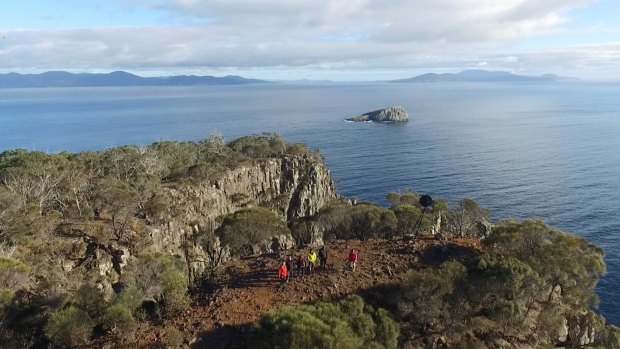This was published 5 years ago
Tasmania: How to conquer Tassie's hilly landscapes on an e-bike
By Andrew Bain

Cyclists on Cape Frederick Hendrick looking out to Maria Island.
Above the east coast of Tasmania, the sky is as busy as the airspace near an airport, except that the "aircraft" here are wedge-tailed eagles, turning, whirling and drifting with the ocean breezes. Far below, deep among the peppermint trees, half-a-dozen mountain bikes glide over the land with much the same ease.
We're pedalling uphill, but the bikes roll seemingly without effort, each turn of the pedals met by a shot of internal acceleration. We're riding e-bikes - electric-assisted bikes - moving in this most contemporary of ways across one of the most historic parcels of land in Tasmania.
"You couldn't fictionalise the crazy stuff that's happened here," says Ben Rea, owner and guide of Tasmanian E-bike Adventures, as we cycle through this swathe of old-growth forest on Bangor, a five-generation family farm layered in Tasmanian history.
It was in Monument Bay, on what is now Bangor, that Abel Tasman made his only landfall in Tasmania, in 1642, and it was on a Bangor beach that first contact was later made between Europeans and Tasmania's Aboriginal people.
It's here now that Tasmanian E-bike Adventures provides visitors with an exclusive look at the property beyond its popular Bangor Vineyard Shed. All they have to do is cycle, aided by these motors that are like an internal tailwind.
We begin at Lagoon Bay - road's end on Bangor - a sweep of white sand with a beauty that belies the fact that it once harboured two whaling stations.
The ride will be as short as it is easy, pedalling up to the tip of the adjoining cape and down to the edge of the beach at its other side.
We set out climbing on a grassy track, whirring gently through the tall native bush that still covers more than 80 per cent of Bangor, with the faint murmur of the Tasman Sea rising up the slopes.
The bikes have four electric settings, from eco to turbo, and as we come to a steeper pinch, I push it into turbo. There's still resistance and effort, but it's chalk and cheese compared to grinding a standard mountain bike up this sort of bumpy slope.
Atop Cape Frederick Hendrick, we're greeted by an expansive ocean view, looking across the sea to Maria Island and the Marion Bay home of MONA owner David Walsh. It's the finest view of the day, but there's more than just beauty here.
"Basically, Tasman dropped his anchor about one kilometre out there," says Rea. "Every explorer thereafter followed Tasman's route, so at the time this was just about the most charted place in the New World."
In 1772, 130 years after Tasman's visit, it also became the site of first contact between Tasmania's palawa (Aboriginal) people and Europeans, on the beach to which we're riding next. It's the presence of such vital history that prompted Ben to seek Indigenous cultural aspects to include in his tours.
Riding with us this day is Sheldon Thomas, one of the four palawa men who revived the art of Tasmanian bark-canoe construction, building the first canoe in the state for 170 years, now on display in the Tasmanian Museum and Art Gallery in Hobart. He has also studied traditional healing methods in central Australia, and on the cape he sits us down, cross-legged, our eyes closed, Above a perfect bay, he performs a healing ceremony accompanied by song and the reverberation of the rocks he claps against the ground.
"I'm just opening up your energy," he says, as the day seems to settle even more calmly over us.
The descent from the cape is along a stony track that leads to the southern edge of Two Mile Beach where, tides permitting, groups can pedal along the white sand with its tragic history. It was here that members of French explorer Marion Dufresne's crew first met a palawa family group, an encounter that ended with the French firing shots, killing at least one person. "That was first contact," Rea says. "Pretty sobering really."
We turn back, riding now towards a spread of oysters and local produce at Lagoon Bay. As the gradient momentarily steepens, I hit a button on my handlebars, switching up to turbo. I roll on, almost effortlessly.
TRIP NOTES
Andrew Bain travelled as a guest of Tasmanian E-bike Adventures.
MORE
discovertasmania.com.au
FLY
Virgin Australia and Jetstar fly direct to Hobart from Sydney and Melbourne; Bangor is a one-hour drive from Hobart. See virginaustralia.com and jetstar.com
CYCLE
Tasmanian Ebike Adventures' Bangor trips run on demand and are tailored to each group, covering between 10 and 30 kilometres. See tasmanianebikeadventures.com.au
Sign up for the Traveller Deals newsletter
Get exclusive travel deals delivered straight to your inbox. Sign up now.